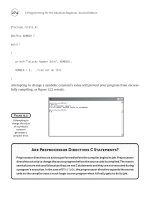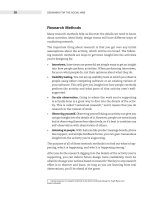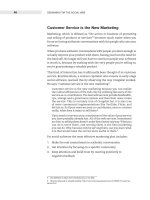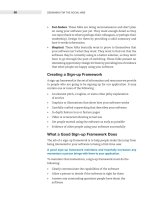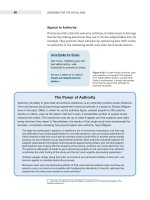designing for the social webj PHẦN 10 docx
Bạn đang xem bản rút gọn của tài liệu. Xem và tải ngay bản đầy đủ của tài liệu tại đây (7.74 MB, 21 trang )
ptg
168 DESIGNING FOR THE SOCIAL WEB
If fewer people are lost on that level of the funnel, then your
changes were positive and you should keep them. If more people
are lost, then you might consider rolling back the changes or making
different ones.
6. Rinse and repeat. Repeat this sequence of steps until you can’t
improve your site any more (is that even possible?), or until the effort
of making changes doesn’t warrant the tiny improvements you’re
seeing. In general, however, there are always ways to improve some
part of your application.
Audience Size vs. Length of Test
The time it takes to figure out how well a design change worked depends
on the sample size of interactions. If your site is big and thousands of
people are using it every day, then you can see the results of design
changes faster. If your site is smaller, with fewer interactions, then you’ll
need to run tests longer to be able to compare against your baseline.
Huge sites like Amazon and Google, which have millions of visitors per
day, have a distinct advantage here. They can run tests for very short
periods of time and see clear results.
Getting Finer-Grained
Let’s imagine for a moment that that funnel analysis told us to take a
closer look at the “Trial Sign-Up” level. Unfortunately, sign-ups are often
a multi-step process, involving several screens of our site as well as a
A Scientific Method?
Astute readers will notice that this set of steps loosely follows the scientifi c method. This is no
accident. Like most things in life, the best designs do not spring from the head of their creator
fully formed. They are the result of an intense process of trial-and-error, thoughtful evaluation,
and endless tweaking. Successful designs rarely look like the idea they started out as; in the
same way a fi nished statue barely resembles the block of marble it once was.
ptg
CHAPTER 8 THE FUNNEL ANALYSIS 169
confirmation email. If our data were pointing to a really leaky sign-up
process, how would we know what to fix?
The answer is a to apply funnel analysis to a specific series of steps.
Take the level that interests you and break it down into its own funnel
for analysis. Here is an example:
100%Site visit
70%Sign-up page view
50%Sign-up
35% Account verification
20%
Account use
Figure 8.3 Sign-up conversion funnel showing the steps you can measure. If one of
these conversion rates isn’t acceptable, you know where to change your design.
The goal with this finer-grained analysis is to break down the sign-up
process into discrete steps. This is easiest if we can map screens to levels,
where every screen in our application matches a level in the funnel.
Analyzing individual steps will allow us to pinpoint exactly what is
wrong with sign-up. Is it the sign-up page? The sign-up form? Or the
verification email?
Tip: Watch out for verification emails! They are notoriously leaky.
I’ve had several clients whose emails were getting lost on the
way to their recipients. Fixing that made a very big improvement
immediately.
Social Funnels
Sign-up is a bugbear in almost all web applications. But there are other
important funnels as well. Figure 8.4 shows a social funnel we can
investigate to improve how frequently people are sharing your content.
For more, see Chapter 7, Design for Sharing.
ptg
170 DESIGNING FOR THE SOCIAL WEB
Of those people who read an article, for example, how many access the
sharing form and send the article to someone else? I’ve highlighted in
green the places where a second person is involved.
100%Read article
40%Fill out sharing form
38%Send share
26%Recipient opens email
Recipient visits site
Figure 8.4 A conversion funnel for sharing. This involves two people, so the
measurement is a little harder. I’ve highlighted the second person’s activities in green.
7%
Analysis During Change
There will be times when you want to make big changes to your design. You might get rid of
screens altogether, either by getting rid of elements or moving them onto other screens. When
this happens, you should evaluate whether your previous baseline is still meaningful.
If you change too many screens at once, the design will be so different that your funnel data
won’t be accurate. The numbers will be off, and your analysis will be distorted.
Here’s how to make these changes. When you’re making the big changes, expand your funnel
far enough back and far enough ahead to measure things that won’t change. Then set your
baseline there, gathering enough data so that you’re confi dent the numbers are stable. So,
you’re effectively changing the baseline before the change, which is crucial to the analysis.
Then, make your changes within the funnel, and watch the beginning and ending numbers.
These will still be valid, while the numbers of the inside levels will be brand new.
ptg
CHAPTER 8 THE FUNNEL ANALYSIS 171
The analysis for all funnels is the same. The important thing is to get
as accurate a measurement as possible of each level.
You’ll also note that desig n changes aren’t always intuitive. For example,
if you’re sending out a sharing email and you add the shared content
right in the email, you might get fewer visits to the site. However, if you
don’t add the shared content right in the email, you might get more
visits to the site, but also more people complaining about it. Design is,
in part, managing these trade-offs.
Issues to Watch For
Funnel analysis is a good way to get a handle on what’s happening in
your web application, but it’s far from foolproof. Here are some issues
to watch out for.
Faulty Baseline
The baseline data is crucial to good analysis. If you don’t change your
design, your funnel percentages shouldn’t change much, either. Traffic
will fluctuate, but your screens should have approximately the same
throughput every day, in terms of percentage. If they don’t, then get
your data consistent before moving on to the other steps in the funnel
analysis. It can take some serious investigation and tracking, but it’s
definitely worth it.
Different Sources Bring Different People
Part of getting a solid baseline is paying attention to where people come
from. People from different sources act differently. If, one day, eight
thousand people come to your site from Digg, they’re going to skew
your numbers. (Digg visitors are notorious for doing drive-bys, where
thousands of people hammer your site for a few hours, mostly window
shopping.) So make sure that you identify regular traffic and spikes in
traffic to get cleaner numbers. This will help you get a better baseline.
Navigation is Non-Linear
Unless you’re measuring a process with defined steps that must be
completed in a specific order, your data is going to include people doing
some odd things. People don’t take a direct, linear path through your
screens. Instead, they might click “back” a few times, reload a page, go
ptg
172 DESIGNING FOR THE SOCIAL WEB
to the home page and start over, or any number of other odd naviga-
tional behaviors.
This will add some noise to your numbers. They won’t always make
perfect sense. But being aware of how truly non-linear navigation paths
are will help you determine when you’re seeing normal behavior and
when you’re seeing something out of the ordinary. This is another reason
why establishing a clear baseline is important. Most of all, you’re looking
for changes in traffic that correspond to design changes.
Size of Numbers
The numbers depend on your type of site. If you’re offering a web-based
tool, then your sign-up percentage should be higher than if you’re run-
ning, say, Wikipedia. Wikipedia sees millions of visitors for every one
that makes a change on the site. In general, if you provide free content
that people don’t have to sign up for, your percentages will be much
lower than if your site exists to sign people up.
What are Reasonable Numbers?
The numbers I’ve shown so far might sound low, but they are very
generous. Most applications will have much lower percentages. The
numbers are different on every site.
Here is a table of actual numbers from feedback Mike McDerment of
Freshbooks got. Notice that most are in the single digits. This is normal.
Ninety percent of all visits are simply that—visits.
Percent of first-time Percent of sign-ups Percent of paying users
visitors sign up become paying users cancel each month
App 1 08.0 3.3 5.0
App 2 6.76 3.75 0.02
App 3 4.7 4.5 7.71
App 4 16.0 11.0 0.4
App 5 0.003 7.8 0
Hopefully, these numbers give you the impression that numbers can
be quite small. The eleven percent for App 4 seems quite high here. But
even changes in numbers this small have a huge impact if you’re getting
ptg
CHAPTER 8 THE FUNNEL ANALYSIS 173
thousands of hits per day. On large sites, even a change of one percent
can mean a huge increase in the population.
Tightening Your Numbers
The funnel analysis depends on accurate numbers. If you can accurately
measure what’s happening, you can make really solid design decisions.
Here are a few ways to tighten your analysis.
.
Create landing pages. Landing pages are special pages where people
from a particular source land and start viewing your site. These
pages are often specially tailored for the situation, with focus on a
particular audience. People can’t browse to them from your regular
site. The key to landing pages is that they are shown only for very
specific audiences. They may come from an email you send out,
an advertisement on another site, or a specific link from your blog.
Landing pages essentially segment your audience for you.
. Measure sets of pages. In the sign-up funnel as well as the sharing
funnel, it makes sense to measure sets of pages at a level. So, for
example, the “Site Visit” level on the sign-up funnel would include
the homepage, a how-it-works page, and any other page that people
learn from before reaching the sign-up page. In the sharing funnel,
all the article pages on your site should be included, so if people
share from any one of them, you’ll know. This makes it easier to
track funnels because you’re allowing flexibility in the navigation
paths of your visitors, but still getting the information you need for
funnel analysis.
.
Segment your funnel. Another way to improve the clarity of
your funnel numbers is to segment general traffic into three cat-
egories: organic search traffic, direct traffic from other sites, and
direct traffic (traffic with no referrals). This will allow you to get
better numbers for each segment, and focus on those segments
that are most valuable.
.
Use in-house metrics. If you set up your own data-collection
system, you’ll know exactly what it is measuring. If you rely on a
third-party system, you might get into guessing games about what
the numbers mean, because you don’t know the particulars of how
they work and what they track. Invariably, if you don’t control your
own collection process, you won’t know all there is to know about
what you are measuring.
ptg
174 DESIGNING FOR THE SOCIAL WEB
The worst way to measure your traffic is by third-party companies who
aggregate traffic for the whole web. Their numbers just aren’t accurate.
Marc Andreessen, who co-founded Netscape and is now working on social
network site Ning, is very much against using these companies:
You can’t believe any of the Internet measurement companies for
any kind of accurate external analysis of Ning usage and traffic—or,
for that matter, usage and traffic of any web site other than perhaps
the very largest.
I’m talking about Compete, Quantcast, Alexa, and even Comscore—
none of their data maps in any way to numbers or patterns we see
in our own server logs and activity metrics.
This is a well-known problem in the Internet startup world and isn’t
discussed often enough.
3
Meaningful Metrics
The metrics that you use in the funnel analysis are crucial to success.
If you weigh certain metrics over others, like prioritizing sign-ups over
comments left on your blog, then your design will change accordingly.
So it is key to choose the appropriate metrics.
The core analysis tool for processes on your site will be the funnel
analysis. But for those things that aren’t easily broken into a funnel
view, you’ll want a broader set of metrics to measure the health of
your application.
The Death of the Page View
For many years page views were the primary metric by which traffic was
measured on the web. As we mentioned in the opening chapter, in the
beginning the web was mostly pages full of text. Now, sites have pages or
screens with widgets, ads, or other elements that we’ve added over time.
Page views have slowly become meaningless, for several reasons:
. Always different. Page views change depending on how the site is
designed. For example, many online news sites split stories up on
several pages to increase ad impressions, although others don’t. Mak-
ing any sense of page views is incredibly difficult for this reason.
3 />ptg
CHAPTER 8 THE FUNNEL ANALYSIS 175
.
Ajax. Ajax-enabled interfaces dramatically reduce page views because
they allow developers to refresh parts of a page without reloading.
If one site uses Ajax and another doesn’t, the one that doesn’t will
have up to an order of magnitude more page views.
. RSS. RSS also changes the value of page views. If your readers are
accessing content via RSS, then their views aren’t counted as page
views even though they’re still reading the full content. If you pro-
vide RSS through your application, then your page view numbers
will not reflect actual content consumption.
For all these reasons, the page view metric is no longer useful or widely
used. Page views are more of an artifact of design choices than an indi-
cator of success. The way you build your site, the technologies you use,
and the way you distribute content shape the page view numbers so
that they no longer represent a true picture of the people visiting and
viewing pages.
Common Metrics
This far-from-exhaustive list can help get you started investigating
metrics. You might just discover a metric for your own application that
makes more sense than any of these.
. Unique visitors. Measures the number of unique people who visit.
This metric gauges how many people are visiting, but gives no insight
into what people are doing once they are there.
. Repeat visits. How often people return to your site. A high number
of repeat visits suggests that people are well-engaged.
.
Time on site. Time on site is the amount of total time a person spends
on a site. High numbers may automatically seem better, but there
are exceptions. Google, for example, doesn’t want time on site to be
very high. They want people to find the best search result as soon
as possible—repeat visits is what they’re after.
.
Pagerank. Pagerank is the metric created by Google that informs their
measure of relevancy for your site. The higher your pagerank, the
more relevant Google thinks your site is. Since Google is a powerful
force on the web that can send a lot of traffic your way, pagerank
cannot be ignored.
. Sign-ups. Number of sign-ups. A high number of sign-ups suggests
that your design is doing well to convince people that your app is
worth it.
ptg
176 DESIGNING FOR THE SOCIAL WEB
. Feed subscribers. Number of people subscribed to a feed (usually
to a blog feed). This is a good indicator of how much attention you
are getting.
. Clickthrough. When your site sends traffic to other sites, it makes
sense to count the number of clicks. Google and other search engines
do this to measure how effective their ads are. Clicks in general are
more accurate than page views, but still suffer from being gamed.
Activities Define the Important Metric
No matter what metrics you choose, you’ll probably have a short list
of extremely important ones. You may even only have a single metric
that defines what you do.
Evan Williams, co-creator of Blogger.com, one of the first blogging
applications, explains why the Blogger team focused on the number of
posts as the important metric for success:
At Blogger, we determined that our most critical metric was num-
ber of posts. An increase in posts meant that people were not
just creating blogs, but updating them, and more posts would drive
more readership, which would drive more users, which would
drive more posts.
4
Notice that there are several things going on here. Returning traffic (often
split out as its own metric) is implicit in this metric, as people who post
more will come back to their site more. Also, Evan assumed that more
4 />Social Metrics
There are also many social metrics that measure user engagement. These include comments
left, number of items shared, number of friends, number of blog posts, number of feedback
messages, number of saved-to-favorites, number of bookmarks, and many others. The rela-
tive importance of each metric will vary according to what your application is built to do.
ptg
CHAPTER 8 THE FUNNEL ANALYSIS 177
posts meant more readers, which isn’t necessarily true but pragmatically
so. Your application will no doubt have its own intricacies. Identify what
activities are most important for your population, and pay attention to
metrics that measure them.
Conclusion
The funnel analysis makes each stage of the usage lifecycle concrete by
explicitly calling out metrics that drive adoption and success. Each web
site will be slightly different, but once you get your baseline metrics in
place, you can confidently measure and make changes going forward.
Yes, there are a lot of steps that each person goes through in using your
application. What the funnel analysis helps illustrate is that each step is
no less important than those that come before or after it, because each
step must be completed in turn.
ptg
This page intentionally left blank
ptg
179
Index
37signals, 52, 89
A
accounts, requiring users to
create, 92, 99–100
activities, 26–27
describing, 27, 29
focusing on primary, 24–26
vs. goals/tasks, 26–27
identifying primary, 26
importance of, 27
researching, 28–31
activity-centered design, 25
Adams, Douglas, vii
adaptive systems
barriers to entry in, 130–131
changing needs of, 127, 142
defined, 127
display of content in, 134–136
examples of, 128
how they work, 128–129
initial actions in, 129–133
leverage points in, 140–142
ordering of content in, 136
role of feedback in, 139
AdaptiveBlue, 87, 88
advertisements
bias in, 12
growth in number of, 11
advertising, word-of-mouth, 144
affiliate programs, 162
aggregation ordering, 136
aggregation systems, 128, 133
Ajax-enabled interfaces, page
views and, 175
AJAX widget, Digg, 140
Alexa, 16
alienation, customers’ sense of,
43–44
Alistapart.com, 106
Amazon
affiliate program, 162
customer reviews, 2–5, 10, 39,
97, 133
and evolution of web, 14
as example of complex
adaptive system, 128
as example of successful
social object, 32
flagging content on, 140
how ownership is conferred
by, 119
how site started, 54
implicit vs. explicit feedback
on, 139
primary activity for, 26, 27
profiles on, 102–103
social features, 36–39
as source of product research,
2
wish lists, 32, 39, 159–160
Amazon Effect, 2–5
analysis tool. See funnel analysis
anonymity, 95, 115
AOF method, 23–40
choosing core feature set,
34–40
focusing on primary activity,
24–31
general steps in, 23
identifying social objects,
31–34
meaning of acronym, 23
purpose of, ix, 40
apologies, how to handle, 58–62
Apple
case studies, 85–86
iPhone video, 72–73
application dashboard, 166
Archimedes, 140
asmallworld.com, 130
Atomiq blog, 142
attachments, group, 98, 122–124
Attention Economy, 12–13
auction site. See eBay
audience, targeting specific,
84–85, 173
authentic conversations, 46–64
handling negative feedback,
57–62
making commitment to,
49–57
ten steps for fostering, 50
value of, 46–48, 64
authority, power of, 88–89
avatars, 100
awareness hurdle, x, 46, 64
Axelrod, Robert, 115
B
Backpack, 89
barriers to entry, 130–131
Basecamp, 27, 82–84
baseline data, 167, 170, 171
ptg
180 DESIGNING FOR THE SOCIAL WEB
BBSs, 13, 16
behavior, showing desired, 120–121
benefits vs. features, 78–79
Benkler, Yochai, 5
Berkowitz, Lawrence, 87
Berners-Lee, Tim, 1, 13, 148
biased advertisements, 12
Bickman, Leonard, 87
Bill My Clients, 70–71
Blinksale, 70–71
blog feeds, 176
blog-tracking site, 19
Blogger, 32, 176
blogs, 19, 42–43, 152, 153
bookmarks. See also social
bookmarking tools
displaying most popular, 136
and Endowment Effect, 121
purpose of, 24
sharing, 145
as social metrics, 176
tagging, 133
Buchheit, Paul, 57
bulletin board systems, 13, 16
Burnham, Brad, 48
business professionals, social
networking application for, 101
C
calls to action, sharing, 148, 149–152
case studies, 85–86
Cathedral and the Bazaar, The, 56
caveat venditor, 63
Cederholm, Dan, 55
Champ, Heather, 52–53
Choice, Paradox of, 11
Christensen, Ward, 13
chronological lists, 136
Cialdini, Robert, 80, 90
Circuit City, 2
classifieds, online, 16
clickthrough metric, 176
Cluetrain Manifesto, The, 41, 43
collaborative encyclopedia, 16.
See also Wikipedia
collaborative filtering, 136
collective intelligence, 128, 142
comment trolls, 98
comment wall, 104
communication, evolution of web,
14–16
communities
building, 52–53
exclusionary, 130
focusing on specific, 53–54
community managers, 50, 51–53
Compete, 19
competitors, copying features from,
40
complex adaptive systems, 127–142
barriers to entry in, 130–131
changing needs of, 127, 142
examples of, 128
goal of, 128, 142
how important content is
displayed on, 134–135
how they work, 128–129
initial action in, 129–130, 133
leverage points in, 140–142
preprocessing of content on, 134
role of feedback in, 139
as ultimate design challenge, 142
complex systems, 125, 127, 128. See
also complex adaptive systems
compliments, 115
connectors, 143–144
Consumerist blog, 62
content
flagging inappropriate, 140
how adaptive systems aggregate,
136
positioning important, 134–135
preprocessing of, 134
printer-friendly, 149
providing free, 172
regulating flow of, 129–130
sharing. See sharing
vs. sharing features, 146
control, providing sense of, 97,
116–118
conversations
authentic. See authentic
conversations
identifying participants in,
99–100
cookies, 26
cooperation
on eBay, 115
requirements for, 115
when reputation is crucial to,
111–114
core feature set, choosing, 34–40
Corkd, 55
Costello, Eric, 33
Craigslist
evolution of, 54
as example of successful social
object, 32
flagging content on, 140
ptg
INDEX 181
founder of, 51
how customer service is viewed
by, 48, 51
importance of community
manager for, 51
popularity of, 16
Creating Passionate Users blog, 124
customer feedback. See feedback
customer reviews
Amazon, 2–5, 10, 39, 97, 133
counter-intuitive economics of,
4–5
vs. manufacturer’s product
information, 3–4
moderating, 133
motivations for writing, 97
customer service
Craigslist example, 51
Dell example, 42–43
as part of marketing plan, 48
as part of social contract with
consumers, 51
Plaxo example, 44–45
publishing your views on, 50
customer testimonials, 82–84, 162
D
Darwin, Charles, 163
dashboard, application, 166
deception, 98
Del.icio.us
as example of complex adaptive
system, 129
as example of personal vs.
network value, 24
as example of successful social
object, 32
explaining target audience for,
84–85
how content is ordered on, 136
implicit sharing on, 145
and tagging, 24, 133
Dell Hell incident, 42–43, 46, 57,
62–63, 64
demographics, 100
Design for Community, 130
design framework, 22
Digg
AJAX widget, 140
as example of complex adaptive
system, 127, 128–129
as example of successful social
object, 32
feedback system, 139–140
getting promoted on, 126
homepage, 135
how content is ordered on, 136
how new content is displayed on,
134–135
leverage points in, 141
popularity of, 17
submitting stories to, 130–132
Top D i gg ers fea tu re, 1 26 –1 27
and traffic spikes, 171
Upcoming page, 126, 129,
134–135, 141
Dodds, Peter, 137
Dogster, 32
Don’t Make Me Think, 70
download statistics, 87
Dreamhost, 58–60
DVD rentals. See Netflix
dynamic content, for profile pages,
104
dynamic web sites, 15
E
eBay
as example of complex adaptive
system, 128
as example of successful social
object, 32
Feedback Profile, 112–113, 115
importance of cooperation on,
115
popularity of, 16
reputation system, 111–114, 115
efficacy
defined, 114
designing for, 115
promoting sense of, 97, 114–115
egocentric software, 16
including testimonials in, 162
junk/unsolicited. See SPAM
personalizing, 159–160
popularity of, 13
sharing items via, 154–155,
157–160
social nature of, 13
verification, 169
web-based, 162
email address, as component of
social web identifier, 99
embeddable items, 148–149
Emerson, Ralph Waldo, 21, 40
emotional attachment hurdle, xi,
124
ptg
182 DESIGNING FOR THE SOCIAL WEB
encyclopedia, collaborative, 16, 32.
See also Wikipedia
Endowment Effect, 119, 121
Engeström, Jyri, 34
entertainment, interactive vs.
non-interactive, vii–viii
entry, barriers to, 130–131
environment
physical vs. social, 8
tension between individual
and, 8–9
errors, apologizing for, 58–62
ethnographers, 29–30
Etsy, 26
“Evolution of Cooperation, The,”
115
exclusionary communities, 130
explicit feedback, 139
explicit sharing, 146
F
and Attention Economy, 13
evolution of, 17
as example of egocentric
software, 16
“Find Your Friends” feature,
81–82
how site started, 54
invitation feature, 162
news feed blowup, 116–118
privacy settings, 118
real-life artifact, 32
fake identities, 100
favorites lists, 36
feature creep, 21–22, 34, 126
features
vs. benefits, 78–79
choosing core, 34–40
copying, 40
keeping a check on, 39–40
feed-subscribers metric, 176
feedback
in complex adaptive systems,
129, 139
implicit vs. explicit, 139
as important part of design
process, 47
options for handling, 49, 50
from passionate users, 47
positive vs. negative, 139
reacting to negative, 57–62
Feedback Profile, eBay, 112–113, 115
feedback scores, eBay, 112–113
“Find Your Friends” feature, 81–82
fi r s t i m p r e s s i o n s , 6 7
First-time Use state, usage
lifecycle, ix, x, 144, 164
Flickr
community building by, 52–53
as example of complex
adaptive system, 129
as example of successful social
object, 32
how content is ordered on, 136
how ownership is conferred
by, 120
how site started, 54
popularity of, 16
primary activity for, 25, 27
purpose of, 16
URLization of photos by, 33–34
forced move, social software as,
10–11
form creation tool, 78–79
forms, sharing, 154–156
free content, 172
free software versions, 89–90
Freshbooks, 166, 172
Freud, Sigmund, 8
friends lists, 101
Friendster, 16, 104
fun features, 98, 122–123
funnel analysis, 163–177
alternatives to, 174–177
article on, 164
and big design changes, 170
customizing, 165
issues to watch for, 171–174
making design decisions with,
166–168
measuring sets of pages, 173
for membership web site,
165–171
purpose of, 164, 177
and sample size, 168
segmenting funnels, 173
tightening, 173–174
and usage lifecycle, 153, 164,
177
funnel diagrams, 164, 165–166,
169, 170
G
Game Neverending, 54
gaming the system, 98
GigaOm blog, 152
Gladwell, Malcolm, 143
ptg
INDEX 183
Gmail, 57, 162
goals, 26–27
Godin, Seth, 88, 89, 153
as example of complex
adaptive system, 128, 129
Gmail, 57, 162
Groups, 99, 122
Maps, 91
relevance algorithm, 136
Search, 17, 133
site metrics, 175, 176
Goplan, 89–90, 136
group attachments, 98, 122–124
group behavior, 7–8
group interaction, 16
“Guided Tour” video, 72–73
H
handles, web site, 99
help documents, 50
homemade videos, 16, 18. See also
YouTube
Hotmail, 162
how-it-works features, 72–77
“How It Works” graphics, 73–75
Huberman, Bernardo, 127
human behavior, social nature of,
6–9
human-centered design, 25
human psychology, social software
and, viii
hurdles, usage lifecycle, xii. See also
specific hurdles
hypotheticals, 89
I
“I Rule” effect, 26
IBM sharing form, 155–156
identify, faking, 100
identity management, 97, 98–105
IMDb, 17
implicit feedback, 139
implicit sharing, 145
individual, tension between
environment and, 8–9
Industrial Age, 10, 11
Influence: the Psychology of
Persuasion, 80, 90
Information Age, 10
information overload, 10–11, 12
intelligence, collective, 128, 142
interactive entertainment, vii–viii
Interested state, usage lifecycle,
ix, x, 164
interface design, viii, 9, 137
Internet. See also web
cooperation among users of, 95
estimated number of users
of, 20
InternetWorldStats, 20
intranets, 153
invitation feature, 162
invoicing application, 70–71
iPhone, 72
iTunes, 40
J
Jarvis, Jeff, 42–43, 62–63, 64
JetBlue, 61
Jobs, Steve, 40
journalism technique, 69–91
K
Karim, Jawed, 18
Kaycee Nicole story, 100
Kiva, 17
Kollock, Peter, 95
Krug, Steve, 70
L
landing pages, 173
Last.fm, 32
laugh tracks, 80
leaky levels, 167
leverage points, 140–142
Lewin, Kurt, 7
Lewin’s equation, 7–8
LibraryThing, 17
Lifehacker, 146
Lifestream feature, 104
LinkedIn, 101, 102, 108–109
list management tool, 32
M
Ma.gnolia, 153
management application, 166
manuals, user, 50
many-to-many conversations,
15–16
Maps, Google, 91
marketing, 41, 48
ptg
184 DESIGNING FOR THE SOCIAL WEB
Martin, Stacy, 44–45
McDerment, Mike, 164, 166, 172
McDonald’s, 87
Meadows, Donella, 142
membership sites, 165, 172
Menchaca, Lionel, 62
Menuism, 27
metrics
choosing appropriate, 174,
176–177
in-house vs. third-party, 173–174
list of common, 175–176
social, 176
Milgram, Stanley, 87, 88
mistakes, apologizing for, 58–62
mobile phones, 91
mobile software access, 91
Monster, 27, 32
motivation research, 95
motivations, identifying and
supporting user, 96–98
Motortopia, 120
movie ratings, 17
movie recommendations, 105–106
movie-rental-by-mail service, 105.
See also Netflix
Movies For You screen, Netflix,
105–106
MSN Groups, 122
MSNBC.com, 157–158
MusicLab study, 137–139
MySpace, 13, 16, 18, 119
N
nature vs. nurture debate, 8
navigation, non-linear, 171–172
Neeleman, David, 61, 62
negative feedback, 57–62, 139.
See also feedback
Netflix
collaborative filtering of ratings
on, 136
as example of complex adaptive
system, 128, 129
as example of successful social
object, 32
goals/activities/tasks for, 27
“How It Works” graphic, 73–74
Movies For You screen, 105–106
primary activity for, 26
recommendation system, 136
Netvibes, 92–93
network value, 24
networked world, designing for, viii
New York Times
most-shared articles screen,
160–161
sharing call to action, 149,
150–151, 152
Newmark, Craig, 51, 54
news feed blowup, Facebook,
116–118
news sites, 17, 133, 136
Newsvine, 153
Nielsen/NetRatings, 20
Nike+, 17
non-interactive entertainment,
vii–viii
non-linear navigation, 171–172
Norman, Dan, 25
notifications feature, 104
nytimes.com, 149. See also
New York Times
O
objects. See also social objects
collections of, 36
fi n d i n g , 3 3
linking to, 33
modeling real-life artifacts as, 32
sharing, 33
online classifieds, 16. See also
Craigslist
online communities, 13
online form creation tool, 78–79
online identity, 98. See also identity
management
online invoicing application, 70–71
online motivation research, 95
online participation, motivations
for, 97–98
online price trackers, 11
open-source manifesto, 56
Orbitz, 92
ordering, aggregation, 136
ownership, conferring sense of, 97,
119–120
P
page views, 174–175
pagerank metric, 175
paid-membership sites, 165, 172
Paradox of Choice, 11
participation motivators, 97–124
allowing for reputation, 109–114
attachment to group, 122–124
ptg
INDEX 185
conferring ownership, 119–120
emphasizing person’s
uniqueness, 105–107
enabling identity management,
98–105
leveraging reciprocity, 107–109
list of, 97–98
promoting sense of efficacy,
114–115
providing sense of control,
116–118
showing desired behavior,
120–121
Passionate Use state, usage lifecycle,
ix, xi, 164
passionate users, 47, 123–124, 144,
162
PatientsLikeMe, 17, 102
PDFs, 149
perfectapology.com, 60, 61
permalinks, 36
permanent URLs, 148
personal computer revolution, 9
personal value, 24
photo sharing site, 16, 25. See also
Flickr
physical environment, 8
Plaxo, 44–45
positive feedback, 139. See also
feedback
Powazek, Derek, 130
price trackers, 11
printer-friendly content, 149
privacy policies, 50
privacy settings, 118
product research, 2
professionals, social networking
application for, 101
profile pages, 100–105
for Amazon, 102–103
for business professionals, 101,
102
defined, 100
imposing restrictions on, 104–105
managing, 104
for patients, 102
personal nature of, 104
static vs. dynamic, 103–104
typical contents of, 100–101
progressive engagement, 93–94
project management application,
89–90
projects, 36
psychology, social software and, viii
public bulletin board systems, 13, 16
public relations, 63
PublicSquare, 136
Publishing 2.0, 152
R
ranking systems, content, 136
RateMyProfessors, 17
Raymond, Eric, 56
reciprocity, 89, 90, 97, 107–109
Regular Use state, usage lifecycle, ix,
xi, 164
“release early and often” strategy,
56–57
relevance algorithm, 136
Remember the Milk, 32
repeat-visits metric, 175
reputation
defined, 109
designing for, 109–110
feedback scores as indicator of,
112
power of, 109
reputation-building, as motivation
for online participation, 97
reputation features
eBay, 111–114, 115
Yelp, 110–111
research
on activity of shopping, 29–31
motivation, 95
product, 2
social influence, 136–139
social psychology, viii, 13, 88, 107
song-download, 137–139
research methods, 28
restaurant reviews, 107–108, 114. See
also Yelp
return visits hurdle, xi, 96
“review of the day” feature, Yelp, 121
reviews. See customer reviews
Rheingold, Howard, 9
Rose, Kevin, 126–127, 140
RSS, 175
S
Saint-Exupery, Antoine de, 65
Salganik, Matthew, 137
sample size, funnel analysis and,
168
Schachter, Joshua, 24
Schneier, Bruce, 118
Schwartz, Barry, 11
ptg
186 DESIGNING FOR THE SOCIAL WEB
Science magazine, 115
scientific method, 168
search engines, 136, 176. See also
Searls, Doc, 43
Seneca, 143
Sermo, 17
shadow application, 166
shared items, 36, 147, 148
sharing, 144–162
allowing for multiple, 157
confirming, 156–157
conversion funnel for, 170
designing form for, 154–156
facilitating, 148–149
how it works, 146–147
implicit vs. explicit, 145–146
placing call to action for,
149–152
providing options for, 153
reasons for, 144–145
steps in process, 148–161
call to action, 149–153
discovery, 148–149
interpreting shared
message, 157–160
taking action, 160–161
using sharing form, 154–157
ways of enabling, 161–162
sharing forms, 154–156
sharing funnel, 173
Shirky, Clay, 100
shopping
describing activity of, 29
ethnographic view of, 29–30
role of social interaction in, 31
shopping carts, 36
shopping sites, 2, 10, 162. See also
Amazon
Sierra, Kathy, 26, 124
sign-up conversion funnel, 169
sign-up framework, 68–91
characteristics of good, 68–69
defined, 68
typical components of, 68
using journalism technique to
design, 69–91
sign-up friction, reducing, 92–94
sign-up funnel, 173
sign-up hurdle, x, 66–69
sign-ups metric, 175
Simon, Herbert, 12
Slideshare, 32, 136, 147
SmartLinks feature, AdaptiveBlue,
88
Smith, Gene, 142
social behavior, 6–7, 9
social bookmarking tools, 24, 78,
84, 133, 153. See also Del.icio.us
social circles, 143
social conduits, 143
social cues, 80
social design, 5–6
social environment, 8
social features, Amazon, 36–39
social funnels, 169–171
social influence study, 136–139
social interaction, 31
social metrics, 176
social network fade, 104
social network sites. See also social
web applications
managing online content with,
153
most popular, 16
why people join, 10, 13
social news sites, 17, 153. See also
Digg
social objects
embedding, 148–149
giving unique URL to, 33–34
successful web sites built
around, 32
social proof, 79, 80, 87
social psychology, father of, 8
social psychology research, viii, 13,
88, 107
social software. See also social web
accelerating growth of, 6, 13–19
challenge of, 9
components of marketing plan
for, 48
as forced move, 10–13
and human psychology, viii
mobile access to, 91
social web. See also social software;
social web applications
and personal vs. network value,
24
reasons behind rise of, 5–20
and usage lifecycle, ix–xi
social web applications
barriers to entry in, 130–131
estimated time spent on, 18
getting people to talk about,
144
growth of, 17–18
most popular, 16–17
new and noteworthy, 17
prioritization scheme for
designing, 23. See also AOF
method
ptg
INDEX 187
purpose of, 17
requiring accounts for, 99–100
why people participate in,
97–98
social wine application, 55
software design
and feature creep, 21–22, 34
and human psychology, viii
and “I Rule” effect, 26
lack of focus in, 22
modeling real-life artifacts as
objects in, 32
prioritization scheme for, 23.
See also AOF method
and sign-up hurdle, 66–69
software download statistics, 87
software interface, viii, 8–9, 137
software support, 50. See also
customer service
song-download study, 137–139
SPAM, 98, 130, 154, 157, 160
spammers, 134
static web sites, 15
statistics
site traffic, 174–177
software download, 87
status feature, 104
stories
company, 50
success, 85–86
Sustainability Institute, 125, 142
T
tags/tagging, 24, 133
tasks, 26–27
Techmeme, 133
Technorati, 19
testimonials, 82–84, 162
time-on-site metric, 175
Times. See New York Times
Tipping Point, The, 143
Top D i gg ers fea tu re, 1 26 –1 27 , 136,
142
touchscreens, 72
traffic spikes, 171
traffic statistics, 174–177
Trapani, Gina, 146
travel itineraries, 74–77
TripIt, 74–77, 92, 93
trolls, 98
trusted sources, 10–11
tutorials, 50
twentieth-century media, vii–viii
Tw i t t e r , 3 2 , 1 2 3
U
UIE sharing form, 154
Unaware stage, usage lifecycle,
ix, x
unique-visitors metric, 175
uniqueness
emphasizing, 105–106
experiment, 107
as motivation for online
participation, 97
Upcoming event calendar, 32
Upcoming page, Digg, 126, 129,
134–135, 141
URLs
for photos, 33–34
for shared items, 148
for social objects, 33–34
writing good, 148
usage lifecycle
defined, ix
and funnel analysis, 163, 164,
177
significance of clearing hurdles
in, xii
stages of, x–xi
Usenet, 13
user-based views, 136
user feedback. See feedback
User Interface Engineering sharing
form, 154
user manuals, 50
usernames, 99
V
verbs, finding your, 34–35
verification emails, 169
video-sharing site. See YouTube
W
Wall Street Journal, 93–94
Watts, Duncan, 137
Wealth of Networks, 5
web. See also Internet; web
applications; web sites
estimated number of sites on,
14
history of, 13–16
invention of, 13
many-to-many conversations
on, 15–16
one-way conversations on, 14
ptg
188 DESIGNING FOR THE SOCIAL WEB
as social vs. technical creation, 1
two-way conversations on, 14
ultimate goal of, 1
web applications. See also social web
applications
building your own, 54–55
as complex social systems, 142
and customer alienation, 44
describing, 70–71
evolution of, 14–16
experimenting with, 56
explaining benefits/features of,
78–79
getting ongoing participation in,
96–97
giving examples of who is using,
79–89
motivating people to sign up for,
65–69
offering free version of, 89–90
reducing sign-up friction for,
92–94
releasing, 56–57
requiring users to create
accounts for, 92
showing end result for, 77
showing how they work, 72–77
showing where people can use,
91
spreading goodwill about, 55
targeting to specific audiences,
84–85
why people participate in, 97–98
web-based mail systems, 162
web forms, 154
web site activities. See activities
web-site analysis tool. See funnel
analysis
web sites. See also web applications
attaching databases to, 14
choosing core feature set for,
34–40
copying features from other, 40
dropping of features by, 126
estimated number of, 14
focusing on primary activity for,
24–26
measuring effectiveness of,
163–177
preprocessing of content on, 134
static vs. dynamic, 15
WELL, 13
Wikipedia
as example of complex adaptive
system, 128, 129
as example of successful social
object, 32
popularity of, 16
site traffic, 172
Williams, Evan, 176
wine reviews, 55
d magazine, 150
wish lists, 32, 36, 39, 159–160
Wodtke, Christina, 44–45
word-of-mouth advertising, 144
World Wide Web, 13. See also web
Wroblewski, Luke, 93
Wu, Francis, 127
Wufoo, 78–79
Y
Yahoo
Buzz, 133
Groups, 122
Mail, 17, 162
Yelp
how desired behaviors are
promoted by, 120–121
leveraging reciprocity on, 107–108
promoting sense of efficacy on,
115
reputation features, 110
“review of the day” feature, 121
YouTube
and Endowment Effect, 119
as example of complex adaptive
system, 129
as example of successful social
object, 32
how ownership is conferred by,
119
how site started, 54
noun/verb analysis of, 35
popularity/growth of, 16, 18, 148
primary activity for, 26
sharing feature, 149, 150
Z
Zuckerberg, Mark, 117–118


